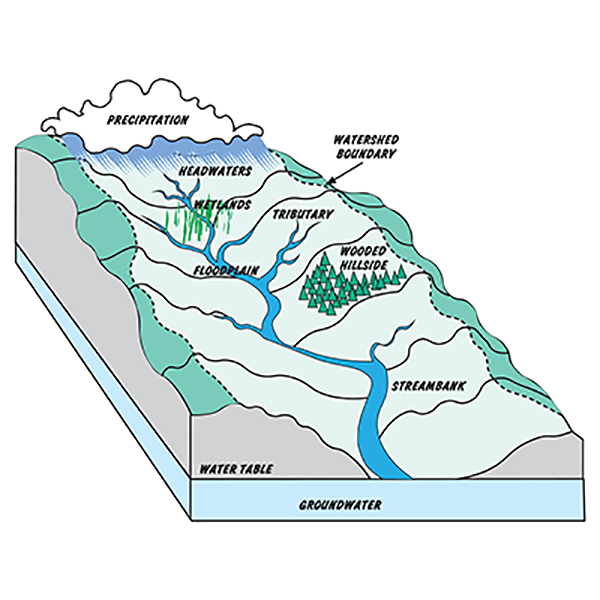What is a Watershed?
 A watershed is the area of land that drains to a common point, such as a stream, lake or wetland. The hills and ridges of the landscape form watershed boundaries. Watersheds can be small or large. Small watersheds are nested within larger watersheds until they reach an ocean.
A watershed is the area of land that drains to a common point, such as a stream, lake or wetland. The hills and ridges of the landscape form watershed boundaries. Watersheds can be small or large. Small watersheds are nested within larger watersheds until they reach an ocean.Everyone lives in a watershed. Water in local streams, rivers and reservoirs becomes the source of drinking water for someone.
What is a Watershed Group?
Watershed groups are affiliated citizens who join together because they care about their local creek or stream. Because of their interest, they often keep an eye on the watershed they connect with. Watershed groups bring attention to important issues, educate the public and complete stream improvement projects. Each watershed group is different, but some common activities include the following:
- Stream Improvement Projects
- Stream Cleanups
- Tree Plantings
- Water Quality Monitoring
- Public Education
- Habitat Restoration
Find a Watershed Group
No matter your interest or skill level, volunteering for a watershed group provides an important service to the community. Get involved with a watershed group in your area.
Use this map to locate one near you
Forming a Watershed Group
Anyone interested and willing to give their time to the improvement of a watershed can form a watershed group. All experiences, skills and knowledge are valued and goals and direction can be entirely self-determined. The work can begin simply with educational walks or a litter-cleanup and eventually embark on stream repair projects. Work with local officials to determine appropriate permissions for your efforts.
The entire region shares similar issues: stormwater and agricultural runoff, abandoned mine drainage, erosion, flooding and development. From these issues, your group should pinpoint specific areas that need improvement or protection. For example, select areas within the watershed to plant a riparian buffer or host litter cleanups. In addition, identify high-quality areas that need to be protected from potential damage.
Establish a monitoring plan before sampling. This can be as simple as going out twice a year to look at stream insects (macroinvertebrates) or taking water quality samples monthly in targeted areas. Contact ACCD to learn how and what to sample. Based on availability, ACCD may be able to provide starter monitoring kits.
Start with stream clean-ups, stream walks with community members or gather funds to plant trees with volunteers. Consider selecting one activity, like scheduling regular litter clean-ups to raise awareness in your watershed. Whatever your path or motivation, watershed groups will make a difference.
Water Quality Monitoring
Environmental agencies cannot provide the full coverage needed to protect water resources. Citizen science monitoring is more important than ever before. Volunteers can provide data and information where agencies are not testing.
Why collect and share water quality data?
Water quality data has many benefits:
- Provides an open access historical record of how waterways have changed over time, which is a useful tool for community groups, municipalities and landowners.
- Acts as a warning system for potential issues in a stream system.
- Evaluates the effectiveness of restoration projects.
- Identifies useful restoration projects.
- Offers educational tools and pathways for community engagement.
Learn More About Watersheds
Find educational resources, webinars, videos and more to help you better steward your environment.